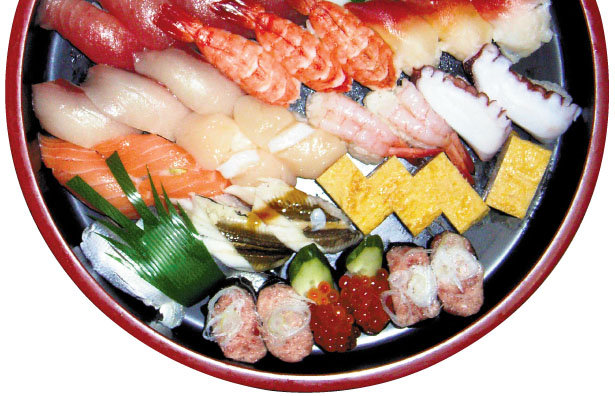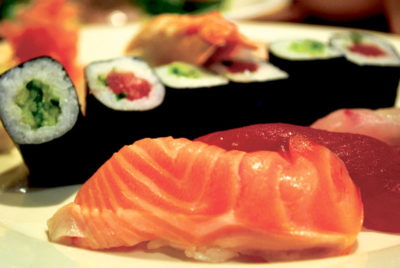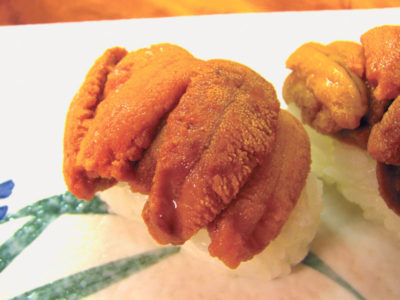Sushi’s many culinary turns
 About 50 years ago, the concept of eating raw fish was utterly mystifying to Americans. Glistening slabs of fatty tuna, untouched by fire’s influence, were seen as foreign harbingers of disease—a product of a far away, unfamiliar land.
About 50 years ago, the concept of eating raw fish was utterly mystifying to Americans. Glistening slabs of fatty tuna, untouched by fire’s influence, were seen as foreign harbingers of disease—a product of a far away, unfamiliar land.
But after plates and minds opened on the West Coast in the 1960s, Americans slowly began embracing Japanese cuisine beyond wok-fried steak, tempura-battered whatever and “oriental” shrimp.

Now, sushi and sashimi are as ubiquitously American as brown hunks of meat covered in viscous gravy were during the 1950s. And that’s not limited to the easily palatable California Rolls, in fact, more and more eaters are embracing the concept of Omakase (chef’s choice).
Omakase is a Japanese phrase that means “I’ll leave it up to you” and ordering it allows a trained chef to dictate the meal based on what is freshest or what he/she wants the eater to experience.
It gives the chef carte blanche to serve that day’s best sushi, sashimi or rolls—and yes, all three are separate items.
It has become the catch-all term for Japanese cuisine featuring raw fish, but sushi refers to the pillow of seasoned rice on which the raw fish is served, while the fish itself is sashimi. Ordering a plate of sashimi means you are getting slices of raw fish—tuna, salmon, mackerel, etc.—in what is the purest taste of this cuisine. There is perhaps no bite as luscious as fatty tuna with a speck of wasabi and just a touch of soy sauce, while placing it on a bed of rice as sushi provides a textural juxtaposition that elevates the bite even further.
 Rolls are an entirely different variation of Japanese cuisine. It is the makizushi sushi roll that first opened the Western world to the mere hint of this exotic meal, with the aforementioned California Roll gently persuading the American palate with cucumber, crab meat (or imitation crab meat), avocado and the challenging-for-some seaweed safely hidden inside the roll.
Rolls are an entirely different variation of Japanese cuisine. It is the makizushi sushi roll that first opened the Western world to the mere hint of this exotic meal, with the aforementioned California Roll gently persuading the American palate with cucumber, crab meat (or imitation crab meat), avocado and the challenging-for-some seaweed safely hidden inside the roll.
From there, rolls have evolved into decidedly inauthentic takes like the Philadelphia roll, with cream cheese and smoked salmon. But just because some rolls are inauthentic, it doesn’t mean they aren’t delicious and downright fun to eat. The Spider Roll is a staple at restaurants, with deep-fried soft shell crab delivering a powerful crunch with its delicate flavor; while other ingredients like jalapeños, smoked chipotle mayo and citrus aioli play with the sushi narrative in a way that infuriates purists, but boast a pleasurable flavor venture that is hard to deny or deride.
 Long Island is rife with Japanese restaurants, with some offering straightforward sushi and others delving deep into the world of Americanized rocking rolls. Kotobuki (1530 Old Northern Blvd. in Roslyn) stands as a renowned local favorite, as does Syosset’s Arata (18 Cold Spring Rd.). Garden City offers Sushi Ya (949 Franklin Ave.) and Koiso in Carle Place (540 Westbury Ave.) is the go-to place for old-school Japanese.
Long Island is rife with Japanese restaurants, with some offering straightforward sushi and others delving deep into the world of Americanized rocking rolls. Kotobuki (1530 Old Northern Blvd. in Roslyn) stands as a renowned local favorite, as does Syosset’s Arata (18 Cold Spring Rd.). Garden City offers Sushi Ya (949 Franklin Ave.) and Koiso in Carle Place (540 Westbury Ave.) is the go-to place for old-school Japanese.
Regardless of the restaurant, eaters would be wise to reach beyond their usual food horizons and sample menu items that challenge their sushi sensibilities. This writer urges you to try sea urchin—or uni—which tastes like the very essence of the ocean. Some restaurants will even crack a raw quail egg atop an uni roll, for what is perhaps the most singularly succulent bite on any cuisine’s menu.



















